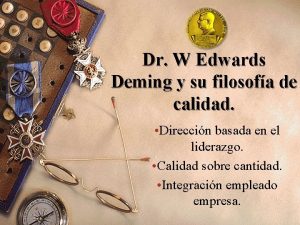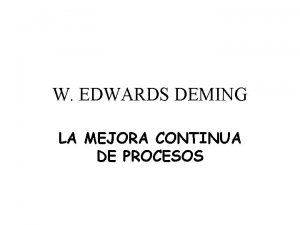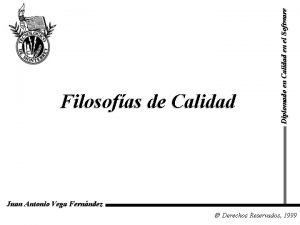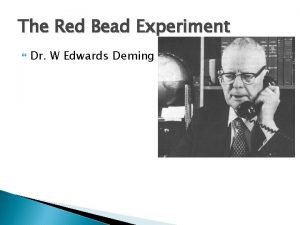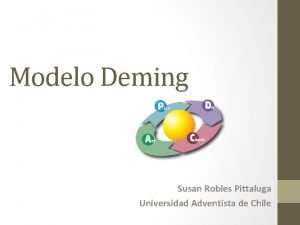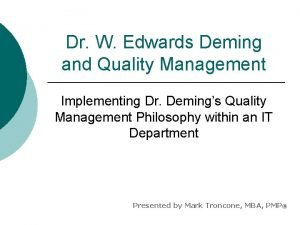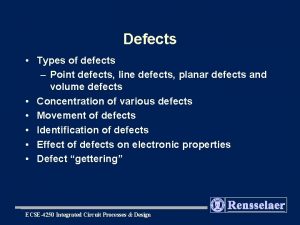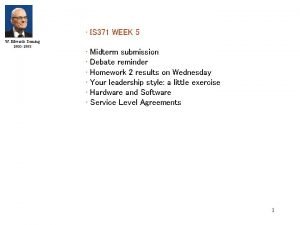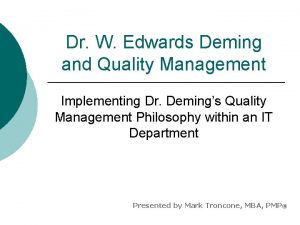Quality and Defects 2 W Edwards Deming 1900











- Slides: 11

Quality and Defects

| 2 W. Edwards Deming (1900 -1993) ▪ ▪ Deming worked on continuous improvement of quality and overall operation Some of Deming’s 14 points for Total Quality Management • Cease dependence on inspection - create products that have built in quality • Continuous improvement • Drive out fear - everyone can work effectively without fear of bringing up problems

| 3 What is a defect? Before we begin, fill out question 1 on the worksheet.

| 4 Defects There are two major kinds of defects: ▪ Design Defects: these are when there are issues with the design of the product. ▪ Manufacturing Defects: Product Design is fine, but things went wrong in the manufacturing process. These are the ones that we, the consumers, see most often and are things like sharp edges or problems that cause early failure. Answer question 2 on the worksheet

| 5 Example: Drive Thru Orders Everybody has gotten the wrong item in their bag at a drive thru at some point. How hard can it be for them to send out only % correct orders? For this exercise, you will need a die, or some substitute that has 6 different options that you can choose from randomly, like 6 cards or pieces of paper.

| 6 Procedure For this activity, we are going to assume that any item in our order has a ⅙ chance of being made incorrectly. To simulate this, any 1’s we roll are going to count as a failure. We will also assume that our order has 5 items in it, so we have to roll the die 5 times for each order. 1. Roll the die and record if it is a one or not 2. Repeat step one five times 3. Record the number of ones rolled on the graph on the next slide by marking an x above the number of ones, example below. 4. Repeat steps 1 -3 five times. X X 0 X X 1 2 X X 3

| 7 Results Based on your results, what is the chance of getting an order with all items correct? You can calculate this by dividing the total number of tests with no ones by the total number of tests taken(5 in this case). If we average everyone's results together, we should get somewhere around 40%, and the whole class plotted on a chart should look like a bell curve (pictured to the right) where there are more results closer to our average than further away from it. But how can we get the number our data is centered on without lots of testing?

| 8 Calculating our expected mean without testing We could find the center of our curve by doing lots of testing and averaging the results afterwards, but for larger projects, that would require 100’s and 1000’s of tests at the minimum. So, to solve for the mean without all of this testing, the first thing we need is the chance to get a “correct” answer for each item. In this case, we have a ⅚ or 83% chance for the item to be right. To find the probability of a full order, we need to multiply the chance for each individual item to be correct together. That means that for five items, the chance for all of them to be correct is ⅚ x ⅚ x ⅚ , or 0. 835, =. 39, or 39% chance.

| 9 Real World example What we just did was an exaggerated version of what happens for drive thrus in real life. We gave them a 83% chance to get each item right. In the real world, they have a 90% chance of getting not each item, but the whole order right. To get to this level of accuracy, that means that each item in an order with five parts needs to have a 98% chance of being correct. This shows that even a 10% difference in accuracy per part can add up to a much lower average overall.

| 10 Work it out! Here’s another simplified example that you can work through by yourself. (Question 6 on the worksheet) What is the chance of getting a heads on a coin flip? What is the chance of getting no tails in two coin flips? What is the chance of getting no heads in three coin flips? What is the chance of getting an odd number and then an even number when rolling a die?

| 11 Work it out! Answers What is the chance of getting a heads on a coin flip? 50% What is the chance of getting no tails in two coin flips? . 5 *. 5 =. 25 = 25% What is the chance of getting no heads in three coin flips? . 5 *. 5 =. 125 = 12. 5% What is the chance of getting an odd number and then an even number when rolling a die? . 5 *. 5 =. 25 = 25%

